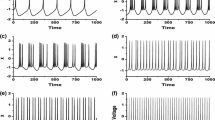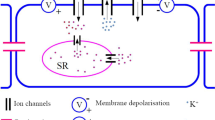Abstract
A simple mathematical model of living pacemaker neurons is proposed. The model has a unit circle limit cycle and radial isochrons, and the state point moves slowly in one region and fast in the remaining region; regions can correspond to the subthreshold activity and to the action potentials of pacemaker neurons, respectively. The global bifurcation structure when driven by periodic pulse trains was investigated using one-dimensional maps (PTC), two-dimensional bifurcation diagrams, and skeletons involving stimulus period and intensity. The existence of both the slow and the fast dynamics has a critical influence on the global bifurcation structure of the oscillator when stimulated periodically.
Similar content being viewed by others
References
Aihara K, Matsumoto G, Ikegaya Y (1984) Periodic and non-periodic responses of a periodically forced Hodgkin-Huxley oscillator. J Theor Biol 109:249–269
Castillo JD, Morales T (1967) Extracellular action potentials recorded from the interior of the gaint esophageal cell of Ascaris. J Gen Physiol 50:631–645
Dong E, Reitz BA (1970) Effect of timing of vagal stimulation on heart rate in the dog. Circ Res 27:635–646
Ermentrout GB (1981) n∶m phase locking of weakly coupled oscillators. J Math Biol 12:327–342
FitzHugh R (1961) Impulses and physiological states in theoretical models of nerve membrane. Biophy J 1:445–466
Glass L, Mackey MC (1979) A simple model for phase locking of biological oscillators. J Math Biol 7:339–352
Guckenheimer J (1975) Isochrons and phaseless sets. J Math Biol 1:259–273 Harmon LD (1961) Studies with artificial neurons, I: properties and functions of an artificial neurons. Kybernetik 1:p89–101
Hirsh MW, Smale S (1974) Differential equations, dynamical systems, and linear algebra. Academic Press, New York
Hayashi H, Ishizuka S (1992) Chaotic nature of bursting discharges in the Onchidium pacemaker neuron. J Theor Biol 156:269–291
Hoppensteadt FC, Keener JP (1982) Phase locking of biological clocks. J Math Biol 15:339–346
Jensen MH (1983) Complete devil's staircase, fractal dimension, and universality of mode-locking structure in the circle map. Phys Rev Lett 50:713–747
Kawato M (1981) Transient and steady state phase response curve of limit cycle oscillators. J Math Biol 12:13–30
Keener JP, Glass L (1984) Global bifurcation of a periodically forced non-linear oscillator. J Math Biol 21:175–190
Kepler TB, Abbott LF, Marder E (1992) Reduction of conductance-based neuron models. Biol Cybern 66:381–387
Kiemel T, Holmes P (1987) A model for the periodic synaptic inhibition of a neuronal oscillator. IMA J Math Applied in Medicine & Biology 4:15–169
Koch C, Segev I (1989) Methods in neuronal modeling: from synapse to networks. MIT Press, Cambridge, Mass.
Morris C, Lecar H (1981) Voltage oscillations in the barnacle giant muscle fiber. Biophys J 35:193–213
Nagumo J, Arimoto S, Yoshizawa S (1962) An active pulse transmission line stimulating nerve axon. Proc IRE 50:2061–70
Nagumo J, Sato S (1972) On a response characteristics of a mathematical neuron model. Kybernetik 10:155–164
Nomura T, Sato S, Doi S, Segundo JP, Stiber MD (1993) A Bonhoeffer-van der Pol oscillator model of locked and non-locked behaviors of living pacemaker neurons. Biol Cybern 69:429–437
Nomura T, Sato S, Doi S, Segundo JP, Stiber MD (1994) Global bifurcation structure of a Bonhoeffer van der Pol oscillator driven by periodic pulse trains. Comparison with data from a periodically inhibited biological pacemaker. Biol Cybern (in press)
Parlitz U, Lauterborn W (1987) Period-doubling cascades and devil's staircases of the driven van der Pol oscillator. Phys Rev [A] 36:1428–1434
Pérez R, Glass L (1982) Bistability, period doubling bifurcations and chaos in a periodically forced oscillator. Phys Lett [A] 90:441–443
Perkel DH, Bullock TH (1968) Neural coding, Neurosci Res Prog Bull 6:221–348
Perkel DH, Schulman JH, Bullock TH, Moore GP Segundo JP (1964) Pacemaker neurons: effects of regularly spaced synaptic inputs. Science 145:61–63
Segundo JP, Altshuler E, Stiber M, Garfinkel A (1991a) Periodic inhibition of living pacemaker neurons. I. Locked, intermittent, messy and hopping behaviors. Int J Bifurcation Chaos 1:549–581
Segundo JP, Altshuler E, Stiber M, Garfinkel A (1991b) Periodic inhibition of living pacemaker neurons. II. Influences of driver rates, of transients and of non-driven post-synaptic rates. Int J Bifurcation Chaos 1:873–890
Stiber MD (1992) Dynamics of synaptic integration. PhD thesis, University of California, Los Angeles
Stiber MD, Segundo JP (1993) Dynamics of synaptic transfer in living and simulated neurons. IEEE Int Conf Neural Networks, San Francisco, pp 75–80
Winfree AT (1974) Patterns of phase compromise in biological cycles. J Math Biol 1:73–95
Winfree AT (1975) Resetting biological clocks. Phys Today 28:34–39
Winfree AT (1980) The geometry of biological time. Springer, Berlin Heidelberg New York
Winfree AT (1987) When time breaks down. Princeton University Press, Princeton
Author information
Authors and Affiliations
Additional information
Supported by Trent H. Wells Jr. Inc.
Rights and permissions
About this article
Cite this article
Nomura, T., Sato, S., Doi, S. et al. A modified radial isochron clock with slow and fast dynamics as a model of pacemaker neurons. Biol. Cybern. 72, 93–101 (1994). https://doi.org/10.1007/BF00205974
Received:
Accepted:
Issue Date:
DOI: https://doi.org/10.1007/BF00205974




